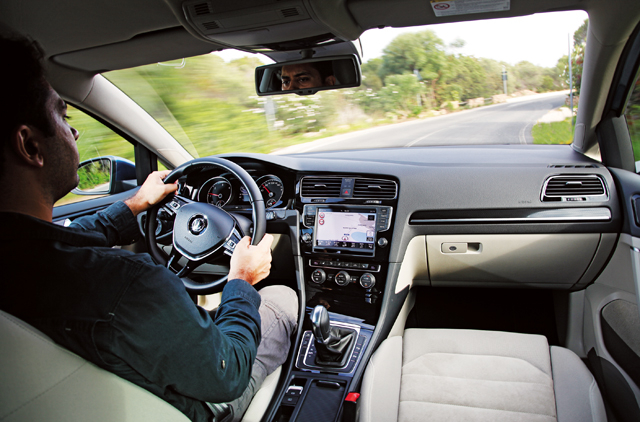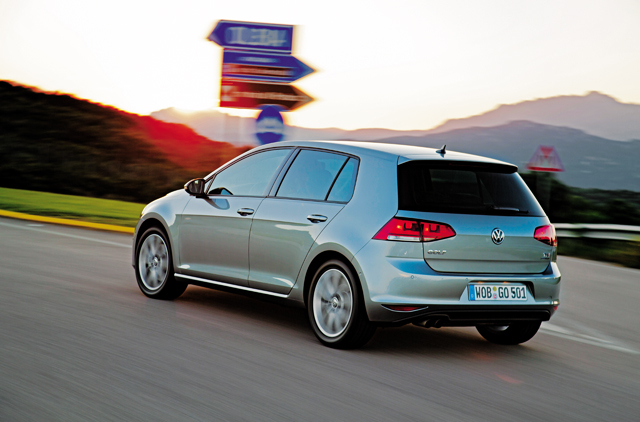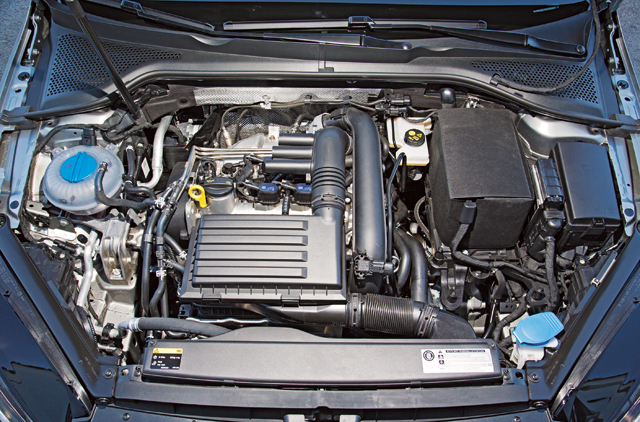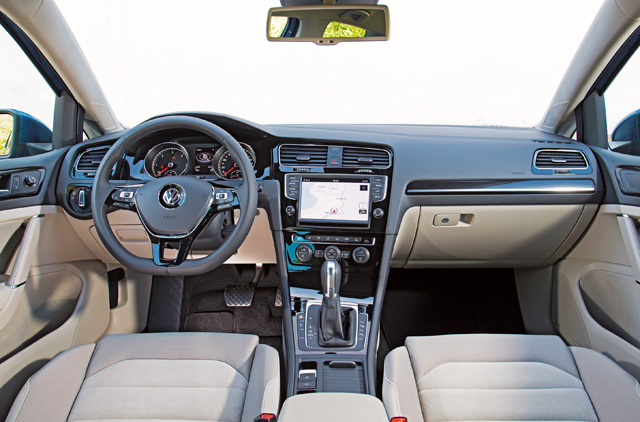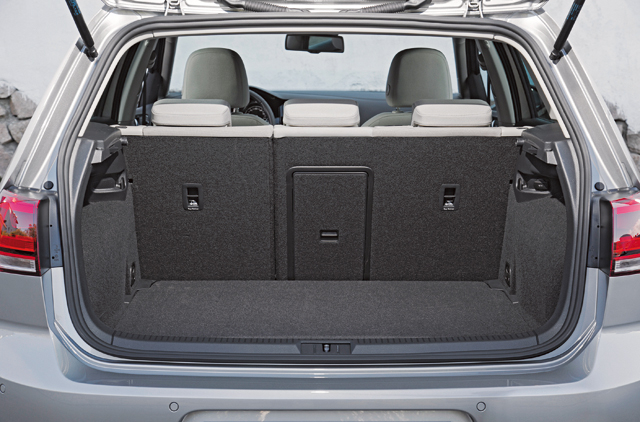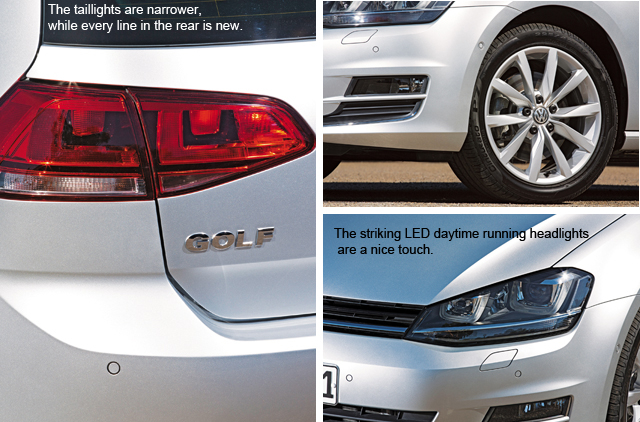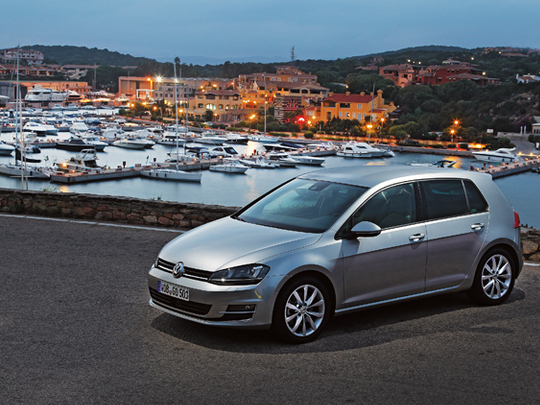
The fact that 29 million units have been built since its debut in 1974, tells you everything you really need to know about the good old Volkswagen Golf — people love it. I’m no different. My favourite was the Mk1. I always liked the simplicity of it, from the elegantly restrained exterior to the bare bones of the interior. Penned by the legendary Giorgetto Giugiaro, the front-wheel drive and front-engined hatchback was the replacement for the Beetle. No pressure.
Subsequent models came and went, and it seemed that the Golf lost its way a little — the third and fourth generation cars seemed just to be going through the motions. The sixth generation was a return to form, and now we’re at number seven. That’s lucky for some. I’m in picturesque Olbia, clutching the key to the fully loaded 140bhp, 1.4-litre TSI, and first impressions are favourable.
The long roof and familiar front remain largely unchanged — the design team’s hands would have been tied when it came to the exterior of the iconic car, and it looks a bit like the previous model, even though it uses 95 per cent new parts. On further inspection however, there are enough cosmetic changes to differentiate it from its predecessor. For instance, the exterior lines have been considerably sharpened up, the wheel arch flares are more pronounced, the kinky C-pillar is, er, kinkier and the headlights are now far more aggressively-styled.
The rear end is still delightfully boxy, while the taillights have lost the rounded outline and mimic the headlights with their distinct corners. The whole thing looks far more taut than before. Some may feel it has lost its friendliness, but the Golf has made more than enough friends over the years. It’s now time to show the world that it has grown up, and you get a sense of that from the size of it. It’s longer by 56mm (4,255mm long) and is 13mm wider (1,799mm wide) than the outgoing model, but 28mm lower in height, making for a self-assured stance.
Headroom doesn’t seem to have suffered either; there was more than enough space for my bonce, but best of all, with a 59mm longer wheelbase, legroom has improved for back-seat passengers, who now have 15mm more space. Even though the new model is quite a bit bigger than before, it actually weighs 1,288kg — that’s an incredible 100kg less than the Mk6. You can thank all manner of weight-saving measures undertaken during the revamp, the most important of which is the greater use of ultra-high-strength, hot-formed steels with far thinner profiles.
I hop into a silver, fully loaded five-door, and I’m blown away by the interior. It’s a cabin that oozes quality and class, and no matter where I prod, there are no cheap materials to be found in here. There’s a very premium feel to it all; everything is within easy reach and user friendly. I love the piano black details and chrome trim — it just adds to the upmarket feel of the car. It’s comfortable too, and offers a fabulous view of the twisty mountain road ahead. It has six airbags and the usual ESP and ABS, but best of all is the extra safety equipment, such as the Multi-Collision Braking System, which automatically applies the stoppers if it detects an impending crash.
Other newbies include Lane-Assist, an anti-fatigue system and radar cruise control. But that’s just the half of it. VW has given the Golf a range of new motors with stop-start technology, an electronic parking brake, and a 5.8in touchscreen infotainment system, which is a major plus point, due to its smartphone-like controls. I push the start button and spark the motor to life — the twin exhausts erupt with a meaty roar. With the direct shift gearbox in D and Sport mode selected, I floor the throttle, and 250Nm of torque pins me back to the seat, as the Golf takes off. Just 8.4 seconds later, I’ve hit 100kph.
I’m loving this motor — it has plenty of pull, and it sips just 4.7 litres-per-100km. The in-line four-pot engine now boasts active cylinder management, which shuts off two cylinders when you’re not caning it to reduce emissions and of course, fuel consumption. Suffice to say, my tester never got the chance to impress me with this new addition. I guess it worked well… Around the twists of Portisco and Pevero, I get to enjoy the peppy motor and the seven-speed DSG to the full. The Mk7 feels far more mature than ever before, and very refined too. It’s also very quiet, and there is hardly any wind noise entering the delightful cabin.
The road begins to get rather bumpy, and in most other cars this would make for an uncomfortable ride, but the Dynamic Chassis Control, which softens and stiffens the dampers (it has five settings; Eco, Comfort, Sport, Normal and Individual), allows you to soak up the potholes with ease. In fact, I come across a range of surfaces on route to the hotel Romanizzo, and the Golf comfortably takes them all in its larger stride. It has more grip than it knows what to do with, the nose goes hunting for corners and the electric steering is exceptionally sharp. I love the way this car is able to change direction — it zips around like an unswattable fly.
Even though it’s front-wheel drive, it has a surprising lack of understeer, and as a result, you end up pushing it hard, yet it copes with everything you throw at it. It’s very impressive — but just imagine what the GTI will be like. Chuck in a huge 380-litre boot, a back bench that three adults can share and a ride that feels more akin to a luxury saloon, and you too will conclude that the new Golf has it all. Volkswagen has nailed this one — it must be that lucky number seven…


